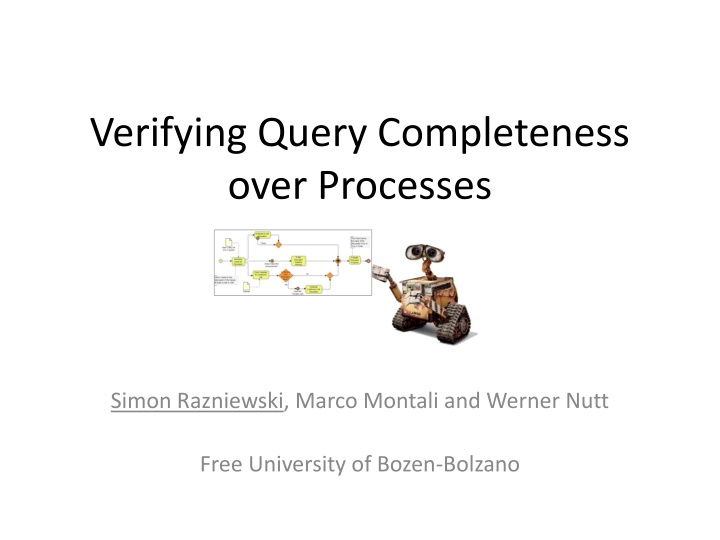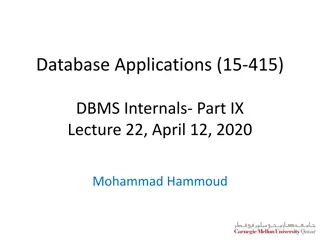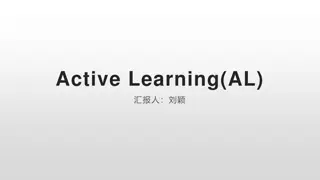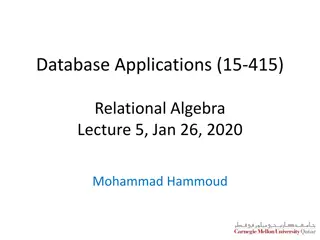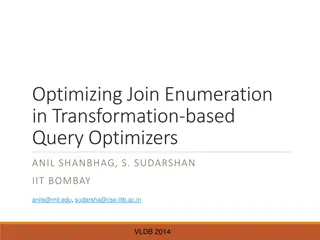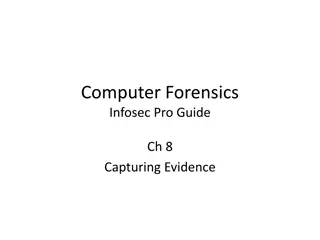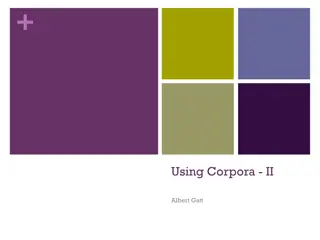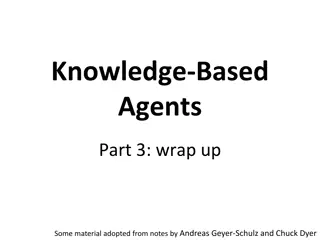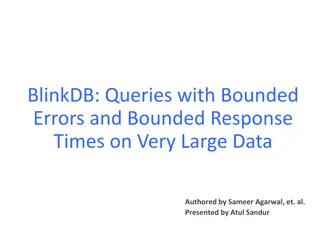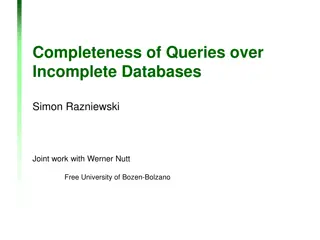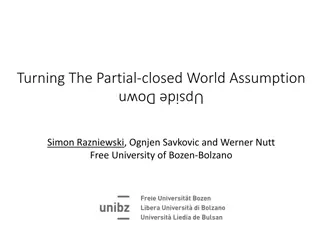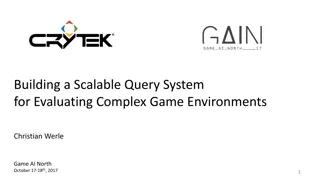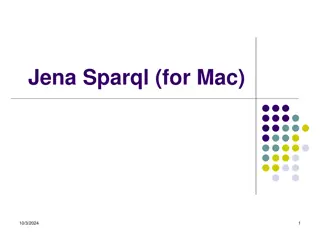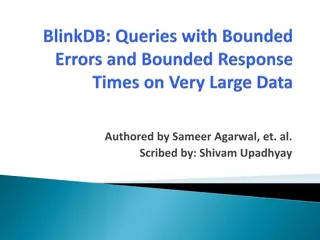Verifying Query Completeness over Processes in School Management Systems
Process execution in school management systems often lacks formalization, leading to delays and incomplete database content. This study explores the challenge of verifying query completeness by examining the interaction between the information system and the real world, using a case study of enrolment processes in a school database.
Download Presentation

Please find below an Image/Link to download the presentation.
The content on the website is provided AS IS for your information and personal use only. It may not be sold, licensed, or shared on other websites without obtaining consent from the author.If you encounter any issues during the download, it is possible that the publisher has removed the file from their server.
You are allowed to download the files provided on this website for personal or commercial use, subject to the condition that they are used lawfully. All files are the property of their respective owners.
The content on the website is provided AS IS for your information and personal use only. It may not be sold, licensed, or shared on other websites without obtaining consent from the author.
E N D
Presentation Transcript
Verifying Query Completeness over Processes Simon Razniewski, Marco Montali and Werner Nutt Free University of Bozen-Bolzano
Observation Often, process execution is only partially formal (pen&paper, email, phone, ) Valid information may be stored in databases with delays Database content is of questionable completeness 2
Background: School Management in the Province of Bolzano Province has central database about pupils, teachers, etc. Would like to answer statistical queries Problem: Data often entered with delays Thus, administrators would like to know whether a query is currently reliable (complete) 3
Enrolment Process in a School Database query: How many pupils? 0 Is that correct? Database query: How many pupils? 137 Is that correct? 4
Observation At some points, new facts in the real world have not yet been stored queries may give wrong answers At other points, all facts that hold in the real world have been stored queries give correct answers 5
Formalization: Two Databases Conceptually, there are - the state of the information system - the state of the real world We model - each state as a database - the process interacting with both Process School database Real world Interaction Interaction 6
Two databases: Example Process School database Real world Interaction Interaction Deciding about enrolments: read from and write into real-world world database Recording accepted enrolments into the information system: read from real-world database write into information system database 7
Completeness Problem Process Information system Real world Interaction Interaction Query: How many pupils are enrolled? Does the information system contain all the enrolments? 8
Research Questions How can we express which data a process generates? How can we express which data are recorded in the information system? How are reads and writes of data related? What does completeness mean? How can we find out whether a query is complete? 9
Model: Quality-aware Transition Systems Goal: General technique applicable to different modeling languages Therefore, we use transition systems as mathematical formalism Petri nets can be encoded using their reachability graph (possibly exponential encoding due to parallelism) Actions in our transition systems can be labeled with two kinds of effects: Real-world effects: allow to create new data in the real world Copy effects: store information that holds in the real world into the information system Thus, our models are data-monotonic 10
Example Revisited Copy effect: Copies the new enrolments into the school database Real-world effect: Generates enrolments Real-world effect: pupilrw(n, s) requestrw(n, s) pupilrw(n, s) pupilis(n, s) Copy effect: 11
Real-world and Copy Effects Real-world effect: pupilrw(n, s) requestrw(n, s) Copy effect: pupilrw(n, s) pupilis(n, s) In general, a real-world effect has the form Rrw(X,Y) Grw(X,Z) where G is a condition, X are bound variables and Y are unbound variables. It allows to introduce new facts Rrw(X,Y), if Grw(X,Z) holds for some Z Real-world effects are nondeterministic, copy effects are deterministic A copy effect has the form Rrw(X), Grw(X,Y) Ris(X) It copies all facts in Rrwthat satisfy Grwinto Ris 12
Completeness Verification Given Process description State S Query Q Question Is it safe to pose the query Q in state S against the information system database? 13
Completeness Verification (2) A state S of a QATS satisfies completeness for a query Q, if for all paths leading to S, for all process-compliant database developments ((Drw0, Dis0), .., (Drwn, Disn)), Meaning: In state S the information system gives the same result as holds in the real world Q(Dnis) = Q(Dnrw) This is what we want to decide! 14
Compliance When does a development ((Drw0, Dis0), .., (Drwn, Disn)) comply to a sequence of real-world and copy effects? 15
Compliance to Real-world Effects request(John,HS) request(Mary,HS) Real-world database Real-world effect: pupilrw(n, HS) requestrw(n, HS) Possible successive real-world databases: Because is nondeterministic request(John,HS) request(Mary,HS) pupil(John,HS) Pupil(Mary,HS) request(John,HS) request(Mary,HS) Pupil(Mary,HS) request(John,HS) request(Mary,HS) pupil(John,HS) request(John,HS) request(Mary,HS) 16
Compliance to Copy Effects Real-world database pupil(John,HS) Pupil(Mary,HS) Copy effect: pupilrw(n, HS) pupilis(n, HS) Resulting information system database . pupil(John,HS) Pupil(Mary,HS) . Because is deterministic 17
Results Completeness over Paths A real-world effect is risky wrt. a query, if it has the potential to change the query result Adding pupils in class 1A is risky wrt. a query for all pupils, but not wrt. a query for all pupils in level 2 Copy effects can repair a risky effect, if they copy all data that has the potential to change the query result Copying all pupils in level 1 into the information system repairs the risky effect. Result: A query is complete over all developments of a path, if all risky actions in the path are repaired Theorem: Repair checking can be reduced to query containment Query containment for conjunctive queries (SELECT FROM WHERE ) has been well studied in database research 18
Results Completeness in States Completeness holds in a state, if it holds for all paths that lead to that state A priori, infinitely many paths (due to cycles) Theorem: Repeated actions can be ignored Thus, only finitely many paths to consider Still, number of paths can be exponential wrt. the QATS 19
Completeness Checking - Intuition How many high school pupils? How many middle school pupils? Middle School A High School B Decide enrolments s3 Record enrolments s6 Record enrolments s1 Record enrolments Decide enrolments Decide enrolments s8 s4 Record enrolments Record enrolments s0 Decide enrolments Decide enrolments s7 s2 Decide enrolments Record enrolments s5 20
Complexity Complexity of completeness checking for a path Complexity of completeness checking for a state Query and effect language Arbitrary conjunctive queries (CQ) P2-complete P2-complete In P2 CQs without <, NP-complete CQs without selfjoins coNP-complete coNP-complete CQs without selfjoins and without <, PTIME in coNP 21
Applications Annotation of statistics and KPI with completeness information (see next slide) Process mining (trace analysis) - to validate whether queries over traces return the real state of the process Auditing to verify whether the information about the real- world is properly stored 22
Possible Use: Statistical Reports School Report 2013 Pupils in primary schools: 548 Pupils in middle schools: 390 Pupils in high schools: 242 Data from the Da Vinci School and the Gherdena School is missing Pupils taking English: 1157 Pupils taking French: 685 Pupils taking Chinese: 52 The Hofer School did not enter its language course attendance yet . 23
Conclusion Introduced the problem of query completeness due to delays between real-world events and their recording in a database Modelling of the problem using quality-aware transition systems that interact both with the real world and with an information system Showed how to verify query completeness over such models Future work: Demo for a high-level process language (BPMN or YAWL) 24
Thank you! Questions? 25
